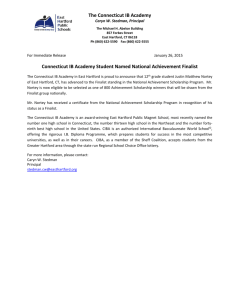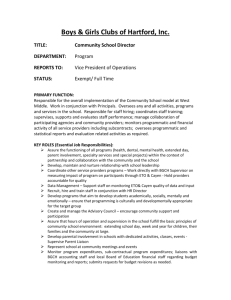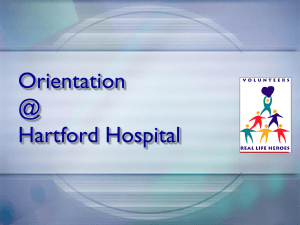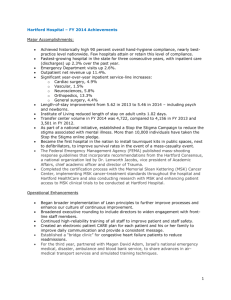Campaign for Hartford Hospital Prospectus
advertisement
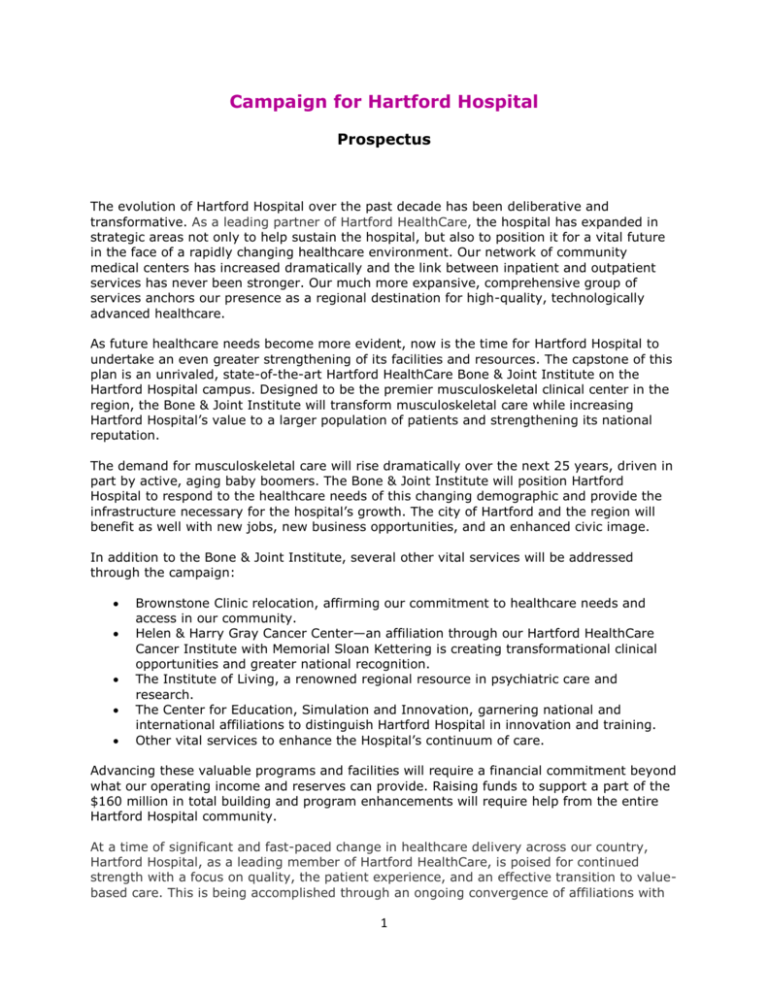
Campaign for Hartford Hospital Prospectus The evolution of Hartford Hospital over the past decade has been deliberative and transformative. As a leading partner of Hartford HealthCare, the hospital has expanded in strategic areas not only to help sustain the hospital, but also to position it for a vital future in the face of a rapidly changing healthcare environment. Our network of community medical centers has increased dramatically and the link between inpatient and outpatient services has never been stronger. Our much more expansive, comprehensive group of services anchors our presence as a regional destination for high-quality, technologically advanced healthcare. As future healthcare needs become more evident, now is the time for Hartford Hospital to undertake an even greater strengthening of its facilities and resources. The capstone of this plan is an unrivaled, state-of-the-art Hartford HealthCare Bone & Joint Institute on the Hartford Hospital campus. Designed to be the premier musculoskeletal clinical center in the region, the Bone & Joint Institute will transform musculoskeletal care while increasing Hartford Hospital’s value to a larger population of patients and strengthening its national reputation. The demand for musculoskeletal care will rise dramatically over the next 25 years, driven in part by active, aging baby boomers. The Bone & Joint Institute will position Hartford Hospital to respond to the healthcare needs of this changing demographic and provide the infrastructure necessary for the hospital’s growth. The city of Hartford and the region will benefit as well with new jobs, new business opportunities, and an enhanced civic image. In addition to the Bone & Joint Institute, several other vital services will be addressed through the campaign: Brownstone Clinic relocation, affirming our commitment to healthcare needs and access in our community. Helen & Harry Gray Cancer Center—an affiliation through our Hartford HealthCare Cancer Institute with Memorial Sloan Kettering is creating transformational clinical opportunities and greater national recognition. The Institute of Living, a renowned regional resource in psychiatric care and research. The Center for Education, Simulation and Innovation, garnering national and international affiliations to distinguish Hartford Hospital in innovation and training. Other vital services to enhance the Hospital’s continuum of care. Advancing these valuable programs and facilities will require a financial commitment beyond what our operating income and reserves can provide. Raising funds to support a part of the $160 million in total building and program enhancements will require help from the entire Hartford Hospital community. At a time of significant and fast-paced change in healthcare delivery across our country, Hartford Hospital, as a leading member of Hartford HealthCare, is poised for continued strength with a focus on quality, the patient experience, and an effective transition to valuebased care. This is being accomplished through an ongoing convergence of affiliations with 1 medical groups, strategic expansion of the hospital’s community medical centers, robust links between inpatient and outpatient services, and a greater focus on caring for the patient well beyond the hospital stay, through a continuum of care that the Hartford HealthCare system provides. We have never been in a better position to realize our full potential as a center of healthcare excellence. We are counting on your help to build the foundation for Hartford Hospital’s third century. Please give in support of excellence for the generations to come. Bone & Joint Institute Under the leadership of Courtland Lewis, MD, and in partnership with Orthopedic Associates of Hartford, we will build a premier, nationally recognized Bone & Joint Institute. It will be the acknowledged regional leader in patient-centered, innovative musculoskeletal care. It will provide state-of-the-art, coordinated, and patient-centered care that integrates all elements of orthopedics and musculoskeletal treatment, including primary and specialty care, diagnostics, rehabilitation, rheumatology, neurology, and pain management. Patients throughout the Hartford Hospital campus will benefit from the Bone & Joint Institute as the additional space the institute will provide will increase the hospital’s capacity of private rooms from 55 percent to 75 percent. To create the first new comprehensive musculoskeletal hospital in New England in decades, we will build on the great work we are already doing in producing the best outcomes for our patients. Most trauma surgery in Connecticut 1,400+ total joints a year 1,000+ spine surgeries a year JCAHO certified joint and spine programs 2 100,000+ outpatient visits a year 7,500+ outpatient surgeries a year Orthopedics Associates, with 30 fellowship-trained orthopedic surgeons, is the largest orthopedic group in the state and shares our vision of developing a premier, nationally recognized institute. The combined experience and resources mean the new institute will be a destination for those seeking the very best care. The Bone & Joint Institute will be a hospital-within-a-hospital with a dedicated staff, dedicated facility, separate cost center, and accountability. The institute will be integrated with our Center for Education, Simulation and Innovation. It will be committed to education and research to develop innovative patient care at a national level, giving medical practitioners and students access to state-of-the-art training and offering our patients greater access to proven, effective treatments for their bone and joint conditions. To provide consistently high-quality and fully coordinated care to all patients, we are erecting new buildings behind the Conklin Building on Seymour Street in Hartford. These new buildings will be designed and hard-wired to provide superior coordinated care. The facility’s inpatient section will consist of five floors of 130,000 total square feet 10 operating rooms 60 private inpatient-room beds diagnostic services orthopedic urgent care public space The institute’s ambulatory and medical office space will consist of three floors of 35,000 total square feet with offices for orthopedics, rheumatology, and neurosciences, and five ambulatory surgery rooms. The institute will dramatically improve the patient experience throughout the hospital as the new buildings free up space across the campus, allowing renovation and modernization of operating rooms and intensive care units and the conversion of more inpatient rooms to private rooms. The institute is expected to enable an increase of private beds from the current 55 percent to 75 percent. Economic factors present some challenges. State and federal budget cuts have reduced support. Still, as we cut costs, it is important to continue to invest in our vision, which is to create a system that provides well-coordinated and consistently great care to more people than ever. The institute will enhance Hartford Hospital’s and Hartford HealthCare’s ability to recruit top physicians to the state. In addition, it will add to Hartford Hospital’s capacity as an economic engine for Hartford and the region and enhance the healthcare reputation of the city of Hartford and the state of Connecticut. The following pages describe other programs and services that will be addressed through the campaign. 3 Brownstone Clinics Relocation In our daily lives, each of us reveals who we are by what we do. Our actions, even more than our words, show those around us what we believe in, what we value and who we are at our very core. At Hartford Hospital, everything we do, whether it is in a patient’s hospital room or in the barbershops, community centers, and church halls of Hartford, reflect this hospital’s core values: Integrity, Safety, Caring, and Excellence. Our involvement in the community is woven into our identity as a hospital. Contributing to the health and well-being of our neighbors isn’t just something we do; it is who we are. The City of Hartford has an unemployment rate of 15.5 percent, a poverty rate of 32.5 percent, and a median household income of $29,000. These factors directly relate to the need for community healthcare settings. Central to the community benefit activities that the hospital provides each year is our Brownstone facility. The Brownstone facility has more than 45,000 visits annually for adult primary, specialty, and dental care for the city’s underserved and uninsured. The Brownstone Clinics are staffed by residents and by attending physicians, many of whom are retired and serve at the clinics part time. They bring a wealth of experience to their roles as they run patient clinics, oversee care provided by residents, and help educate residents and fellows. However, the building in which they care for patients is outdated and has not undergone extensive renovation in more than 40 years. The capacity of the clinic is limited and providing more primary care is not possible in the existing footprint. Funding would allow 4 Hartford Hospital to carry out our plans to relocate the Brownstone Clinic to a renovated building on Jefferson Street in Hartford. This new multispecialty clinic will allow us to improve patient flow, enhance efficiency, and ensure safety for our patients. Patients will have easier access to better and more dignified care in a setting more conducive to contemporary medicine. Also reflecting on the hospital’s commitment to the community is the vision for a Mobile Market. Center for Education, Simulation and Innovation Last fall, thanks to a state grant of $15 million and approval by the City of Hartford Planning and Zoning Commission, we began expanding our world-class Center for Education, Simulation and Innovation (CESI), further differentiating our hospital as a national and international leader in medical technology and training. The state-of-the-art facility is the centerpiece of our vision to advance the medical educational system. As the second largest surgical center in New England and the Northeast’s largest robotic surgery center, Hartford Hospital continues to be a hub for medical training. The expansion began with the renovation of 6,000 square feet of the second floor of the Education and Resource Center (ERC). The second phase will be a new 25,000 square-foot, two-story building next to the ERC projected to open in January 2015. In Fiscal Year 2013, CESI’s staff trained more than 10,500 care givers. We expect to train more than 11,000 medical personnel this fiscal year—many of them Hartford Hospital and other Hartford HealthCare staff members. We are the major teaching hospital for most of the University of Connecticut’s residency programs. Medical providers have traveled from around the world, including from Europe, Asia, and South America, to train at CESI, as have members of the Army National Guard and U.S. Navy. CESI also offers virtual training locally, regionally, nationally, and globally through advanced information technology systems that our expansion will improve. We are working to make CESI self-sustaining through partnerships with high-tech industries. CESI already is involved with Medtronic, Laerdal, Intuitive, and others. The state of Connecticut’s investment affirms CESI’s ability to attract high-tech industry and contribute to the state’s economic growth. Critical Care Capacity Hartford Hospital is proud of its reputation as a premier provider of innovative and complex care in our region. As central Connecticut’s leading tertiary medical center with a worldclass medical staff, our ability to provide the highest level of care is widely recognized. In 2013, 4,000 patients were transferred here from other hospitals throughout the region for the innovative and complex care that distinguishes Hartford Hospital. As the facilities master plan was developed, the lack of intensive-care-unit and stepdown beds was identified. Throughput is hampered by the lack of these beds. Twenty-four additional intensive-careunit beds are required. A total of eight intensive-care beds were added on Bliss 9 and Bliss 11 from 2010 to 2012. In addition, 15 intensive-care beds are slated to open with the refurbishment of Center 8 into an intensive care unit in December 2014. 5 Helen & Harry Gray Cancer Center Multidisciplinary Cancer Center Clinic Hartford Hospital’s Helen & Harry Gray Cancer Center is the largest and most comprehensive cancer center in our region. Hartford Hospital’s physicians and staff care for approximately 15 percent of Connecticut’s cancer patients. A key hallmark of our care model is the collaborative approach to care for our patients. A multidisciplinary team of physicians and other providers consults with the patient and family and collaboratively develops an evidence-based treatment plan personalized for that patient’s care. Nine different site specific teams made up of surgeons, radiation oncologists, medical oncologists, radiologists, pathologists, and other specialists, including pulmonologists, gastroenterologists, ENT’s, neurosurgeons and neurologists, as well as research nurses, nurse navigators, genetics counselors, dieticians, social workers, psychologists, and others, meet weekly to discuss new patient cases and develop consensus on management. Patients see their physician team members in consultation in their offices on the hospital campus or in satellite offices in surrounding towns closer to their home. While we attempt to ensure rapid access to consultation, arranging visits to two or three specialists shortly after diagnosis may result in some delays as well as multiple trips to physician offices. Patients who are not feeling well or recovering from recent surgery may find that accessing our downtown location multiple times is not a pleasing experience. Similar forms and intakes are completed multiple times, and important clinical information is not always readily available to the clinician. The patient does not always have the perception that their physician team members communicate well with one another or their primary care physician (PCP) to ensure a collaborative and holistic approach. Hartford Hospital lacks a permanent location where the patient’s entire team of doctors and support staff are able to see a patient jointly, to conference and collaborate together, to develop a consensus concerning treatment, and to communicate that plan to the patient and family. Although we do this work “virtually” very well and take our collaboration and communication responsibilities seriously, we know that selected patients report greater satisfaction with a multidisciplinary team experience in a single geographic setting. We also know that this type of setting provides greater patient convenience by avoiding multiple trips, ensures that all clinicians have the same complete clinical data set, and reassures the patient that all team members are collaborating optimally on their behalf. In particular, for those patients who have already seen physicians elsewhere and are looking for an expert second opinion, this type of “one stop” setting is particularly appealing. Multidisciplinary cancer center clinics in places like Dana Farber, Yale, and UCONN have therefore been successful in providing this type of service. We would anticipate that a majority of patients might continue to visit with their doctors utilizing the conventional approach, particularly since offices in suburbs might be convenient for them. However, we would anticipate that a significant percentage might prefer a single visit to a single setting if available. Also, we believe that many patients will perceive this multidisciplinary cancer center clinic (MDCCC) as a true academic cancer center with all specialists present. Many of our physicians relate stories that a visit to their office is not perceived to be a “cancer center” visit. Clear branding of the MDCCC with the Helen & Harry Gray Cancer Center (HHGCC) logo will be essential as we attempt to create an identity of HHGCC that represents Hartford Hospital’s Cancer Center anywhere our physicians and staff render cancer care. 6 Hartford Hospital leadership has identified space for a multidisciplinary cancer center clinic on the second floor of the Medical Office Building at 85 Seymour Street on the hospital campus. It will contain space where surgeons, medical oncologists, radiation oncologists, and other specialists and members of the support team can meet with the patient during the course of a single visit to help delineate an individually tailored approach to care. Conference space within the center will facilitate team collaboration and discussions and also patient and family meetings. Psychologists, genetics counselors, dieticians, social workers, and other team members will also use the space to help support patients and families during their cancer journey. The new Hartford Hospital Multidisciplinary Cancer Center Clinic will have high visibility at our medical center and in our community. We know that identified multidisciplinary cancer centers attract patients diagnosed elsewhere who wish to come to seek expert opinions and care. The MDCCC will become a major entry and care hub of our cancer program and its collaborative activities. The Hartford Hospital Gray Cancer Center MDCCC does not replace our HHGCC offices, Avon location, suburban locations, and satellite offices for patients wishing to access individual team members in those convenient locations. However, it will provide an attractive option for patients who wish access to an entire team of providers who will generate a thoughtful, collaborative, personalized plan during a single office visit. It will serve as a central location for multidisciplinary activities for our cancer center and have wide community recognition for excellence in comprehensive cancer care. The Institute of Living The United States is experiencing a suicide epidemic, as tragically the overall suicide rate increased by 16 percent between 2000 and 2010. Suicide rates are up in virtually every sub-population group. Especially concerning are the increased rates in adolescents and special populations, like returning veterans and the unemployed. Suicide, in fact, is now the leading cause of death by injury. The Institute of Living has been responding over the last several years in a variety of ways to enhance our assessment of suicidal risk and our efforts at intervention, leading to the launch of the Suicide Prevention Initiative, which will now enhance programs and research efforts to combat suicide. Action steps will include a new coordinator of suicide initiatives position, an augmented Dialectical Behavior Therapy program, a Cognitive Behavioral Therapy for Suicidal Patients program, staff training, community education, research on suicide and mental and psychotic disorders, and neuroimaging studies. Funding for the Suicide Prevention Initiative will help save the lives of many who consider suicide an option. Movement Disorders Center Hartford Hospital seeks to establish a movement disorders program to allow us to continue to grow our vision of becoming a comprehensive neurosciences institute within the Greater Hartford region. Such a center would provide the hospital with the opportunity to treat and diagnose patients with all types of neurological disorders and to compete with the nation’s most advanced organizations. A foundation for the program would include recruiting the region’s top movement disorders specialists, establishing an operational space for diagnosis and treatment, and committing to technological resources for deep brain surgery capabilities. 7 Hartford Hospital currently operates successful neuroscience programs in general neurology, stroke, epilepsy, head injury, and psychiatry. The success of these programs in providing quality, cost-effective care has helped us develop a strong reputation in the region in the delivery of care for neurosciences. With a comprehensive Movement Disorders Center we would also be able to offer services for patients with Multiple Sclerosis, Parkinson’s Disease, Huntington’s Disease, Tourette’s Syndrome, tremors, and many more movement disorders, all in a comprehensive neurosciences institute. Research Hartford Hospital’s reputation for providing complex and innovative care to those in need is built on the foundation of excellence in patient care, teaching, and research. Research at Hartford Hospital is designed to respond to a dynamic healthcare environment and the hospital’s ongoing mission to improve patient care and outcomes and deliver state-of-theart technologies and therapies supported by a world-class team of clinicians, nurses, and medical technicians. In the conduct of research, investigative findings have improved patient health and the delivery of medical care in the Greater Hartford community, and has contributed to innovation and enhancement of national and international healthcare. Research in the areas of cardiology, oncology, and psychiatry are especially robust. The John Kelley Springer Courtyard John Springer was the 18th president of Hartford Hospital, from 1976 to 1989, and the first chief executive officer of Hartford Healthcare. He had a relentless passion for education and was an extraordinary leader and a beloved figure in the Hartford Hospital community. He was an innovator who led our institution into a new era of patient safety, quality, and excellence. By creating the LIFE STAR air medical program, he transformed our region’s access to critical care. Hartford Hospital is in the midst of efforts to develop an Academic Zone on the north side of the hospital’s campus. This is currently home to the Center for Education, Simulation and Innovation, which trains more than 10,000 caregivers a year. A memorial courtyard in Mr. Springer’s honor will be a welcome complement to this educational area, providing a large gathering space, quiet areas of respite, and a multi-season flowering garden for patients and families. 8 Tallwood Urology & Kidney Institute The Tallwood Urology & Kidney Institute provides comprehensive urological and kidney care using today’s most advanced treatments. Tallwood’s urologists and nephrologists (kidney doctors) are recognized leaders in their fields. Many pioneered treatments that have become the gold standard of care nationwide. To ensure fully integrated medical and surgical management of all urologic and kidney disorders, the institute has six interdisciplinary disease management teams whose comprehensive services include General urology Stone disease Men’s health Urologic cancer: kidney, prostate, bladder, testes Pelvic health: incontinence, pelvic organ prolapse, and other pelvic floor disorders that are widespread and affect women and men of all ages Medical management of kidney disease To continue to provide the most advanced treatment options, the institute is seeking space and resources for multidisciplinary clinics treating small renal masses, men’s health, stones, and chronic kidney disease. It is also in need of funding for psychology services for pelvic health and men’s health, chronic kidney disease navigation, and resources for research. Nursing Education Key to the high-quality care that Hartford Hospital delivers to patients every day is our nursing staff. As nurses comprise the largest workforce in healthcare, their influence on the quality of patient care is significant. Their skills in critical thinking, leadership, case management, and health promotion, and their ability to practice across a variety of inpatient and outpatient settings are invaluable to Hartford Hospital. But delivering increasingly complex care to an increasing number of patients puts great demands on our nurses. In addition to a strong base in nursing and clinical knowledge, we ask our nurses to bring a broad set of capabilities, including: the ability to plan for transitions in care, the ability to accommodate diverse patient and family needs related to culture, and the ability to teach, mentor, and develop colleagues. We also depend on our nurses to understand the financial implications of care, aspects of preventive care, as well as outcome measures. Recognizing the critical role our nurses play in fulfilling our mission of improving the health and well-being of the communities we serve, Hartford Hospital is dedicated to supporting the future of the profession through continuing education. One program in particular that allows the hospital to keep pace with the direction of nursing is the on-going education of associate-degree registered nurses (RNs) pursing Bachelor of Science in Nursing (BSN) degrees. About 47 percent of Hartford Hospital’s nurses do not have a BSN; they are not obligated to get one. But as we value all of our nurses and recognize the unique skills that baccalaureate-prepared nurses bring, we encourage and strive to financially support our RNs pursuing the completion of their BSN. 9 Contributions to Hartford Hospital’s RN-to-BSN initiative make a tangible difference in the lives of every patient we serve. Nurses with BSNs are well-prepared to meet the demands placed on today's caregivers. BSN programs provide the community experience that prepares RNs who work in acute-care settings to better understand patient needs before and after discharge. BSN courses in microbiology, pharmacology, human development, and nutrition enhance the scientific background of our nurses. BSN graduates also complete course work in ethics and leadership, which stress critical thinking and prepare graduates for challenging environments. In addition, there is a strong emphasis on written and verbal communication skills in BSN programs, which prepare students to collaborate in interdisciplinary groups and to advocate for patient safety. Our nurses are critical to Hartford Hospital’s mission of providing exceptional patientcentered experiences. Your investment in the future of our nursing staff will have a direct impact on the high-quality, safe, and compassionate care we provide our patients, their families, and our community for years to come. 10


